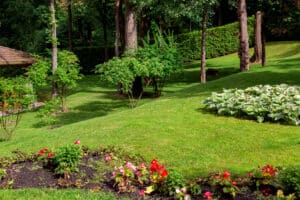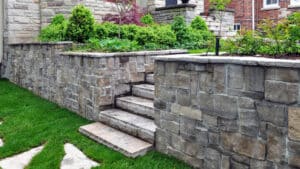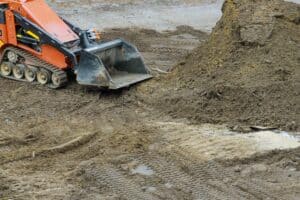August 7, 2023
A Guide To Preventing Soil Erosion For Your Landscaping
The soil in your yard or commercial property is the foundation of your landscaping.
It is where your plants and trees grow, and it is essential to maintain their stability.
However, soil erosion is a natural process that occurs when the soil is destabilized, resulting in costly landscaping problems.
Soil erosion is defined as the process of soil particles being carried away by water or wind and can cause a variety of problems, such as unsightly gullies, and can even damage foundations.
To prevent this, it is crucial to implement appropriate measures to stabilize the soil. In this guide, we will go through various ways to prevent soil erosion and also explore soil repair services.
Types of Soil Erosion in Landscaping
Soil erosion in residential landscaping is generally caused by water and wind, but the specific forms it takes can vary. Here are some of the most common types:
- Splash Erosion: This occurs when raindrops hit bare soil. The impact breaks up the structure of the soil, causing particles to be splashed away.
- Sheet Erosion: This is the removal of soil in thin, uniform layers (sheets) by raindrop impact and shallow surface runoff.
- Rill Erosion: This happens when runoff water forms small channels as it concentrates and flows down the slope. These are typically a few inches deep and not too wide.
- Gully Erosion: This is a more severe form of rill erosion. Runoff water concentrates and flows in an established channel, leading to the formation of deeper gullies.
- Wind Erosion: This occurs when strong winds blow loose, dry, bare soil. Wind erosion is more common in arid areas but can occur anywhere with these conditions.
- Tunnel Erosion: This type of erosion occurs when subsurface soil is removed by water flowing through subsoil tunnels. It’s often associated with poor drainage and can lead to the formation of sinkholes.
It’s important to note that while these are the most common types of erosion found in residential landscaping, the specific types and severity of erosion can vary based on factors like the local climate, the slope of the land, the type of soil, and the landscaping practices used.

Plant Ground Covers For Erosion Control
Soil erosion is a significant environmental concern that affects both rural and urban landscapes.
It’s a natural process where wind, water, or even human activity wears away the topsoil, which can lead to loss of nutrients, reduced soil fertility, and damage to natural habitats.
But there’s a green, sustainable solution to this problem—planting ground covers.
The Role of Ground Covers in Erosion Control
Ground covers are low-growing plants that spread across the ground, forming a dense mat of roots and foliage.
This living carpet serves as a protective barrier, shielding the soil from the impact of raindrops and the erosive power of wind.
They not only enhance the beauty of your landscape but also provide stability to embankments and slopes, preventing soil displacement.
The most easily recognized benefit of ground covers is their quick delivery for healthy growth in areas that often are inhospitable to other plant varieties.
When planted under trees, ground covers reduce mower damage to the base of the tree and require less sunlight and moisture.
Choosing the Right Ground Cover for Erosion Control
Different types of ground covers offer varying benefits when it comes to erosion control. Here are some top choices:
- Ajuga: Also known as bugleweed, this hardy plant forms a thick carpet of foliage, making it an excellent choice for erosion control.
- Cotoneaster: This plant, with its spreading branches and small, shiny leaves, is another excellent option. It’s robust and adaptable, capable of thriving in a variety of soil conditions.
- Marigolds and Ryegrass: These plants can protect soil from erosion while adding beauty to your garden.
- Hydromulch: While not a plant, this ground cover comprises of a slurry of seeds and mulch. It’s often used in areas prone to erosion and has shown effectiveness in controlling soil displacement.
Implementing Ground Covers in Your Landscape
Planting ground covers for erosion control involves careful planning and maintenance.
Start by assessing your soil type, sunlight exposure, and local climate.
Choose a ground cover that’s well-suited to these conditions for the best results.
Then, prepare your land by removing weeds and amending the soil if necessary.
Once your ground covers are planted, regular watering and occasional pruning will ensure they grow thick and healthy, providing maximum erosion protection
Plant cover protects the soil by intercepting raindrops, impeding run-off flow, and dissipating the associated energy.
Without adequate ground cover, up to 85% of rainfall could turn into run-off, contributing to soil erosion.
By planting ground covers, you’re not only beautifying your landscape but also playing a part in preserving our environment.
Mulching To Prevent Soil Degradation
Mulching is an essential gardening practice that brings numerous benefits, including preventing soil erosion, maintaining soil nutrients, and improving the overall health and aesthetic appeal of your garden.
The Significance of Mulching
Mulching involves spreading a layer of material over the surface of the soil. It serves many purposes:
- Preventing Soil Erosion: Mulch protects the soil from being washed or blown away by rain and wind.
- Retaining Moisture: By reducing evaporation, mulch helps the soil retain moisture, meaning you’ll need to water less frequently.
- Weed Suppression: A layer of mulch can prevent weeds from receiving the light they need to grow.
- Temperature Regulation: Mulch acts as an insulator, keeping the soil cooler in the summer and warmer in the winter.
Types of Mulch
Mulch can be organic or inorganic:
- Organic Mulches: These include wood chips, straw, grass clippings, compost, and leaf mold. Organic mulches improve the soil structure, drainage, and nutrient-holding capacity as they decompose.
- Inorganic Mulches: These include gravel, stones, black plastic, and landscape fabric. Inorganic mulches are primarily used for weed suppression and don’t improve soil quality as organic mulches do.
How to Chose the Right Mulch
The choice of mulch depends on the type of plants, soil conditions, and climate.
For moisture-loving plants in dry climates, organic mulch like wood chips or straw can help retain water. In wet areas, inorganic mulch like gravel can prevent soil from becoming overly soggy.
Applying Mulch
Here are some tips for applying mulch to your garden beds:
- Clear the Area: Remove any weeds from the area before applying mulch.
- Apply at the Right Time: The best time to apply mulch is in late spring or early summer when the soil has warmed up.
- Ensure Correct Thickness: A 2-3 inch layer of mulch is typically sufficient for weed suppression and moisture retention. However, avoid piling it against the stems of plants or tree trunks to prevent rot.
- Refresh Each Year: Organic mulches break down over time and should be replenished annually. But be careful not to over-mulch, as too much can suffocate plants and prevent water penetration.
Mulching is an effective way to prevent soil erosion while also contributing to the health and appearance of your garden. Choosing the right type and applying it correctly can make all the difference in the outcome.

Retaining Walls To Reduce Soil Erosion On Steep Slopes
Retaining walls serve as a practical solution to this problem, particularly in landscapes with steep slopes.
These structures provide support to the soil, preventing it from sliding downhill and reducing the speed of runoff, thereby minimizing soil erosion.
They also add aesthetic value to your landscape, providing opportunities for tiered gardening and adding architectural interest.
Selecting the Right Materials and Design
The effectiveness of a retaining wall depends largely on its design and the materials used. Here are some aspects to consider:
Materials: Common materials for retaining walls include concrete blocks, natural stone, wood, and brick. The choice of material often depends on the aesthetics you want to achieve, the level of maintenance required, and your budget. For instance, while wood may be less expensive and offer a natural look, it may not last as long as stone or concrete.
Design: The design of the wall will depend on the slope, soil type, and the amount of load the wall needs to bear. Factors such as drainage and wall height also need to be considered. It’s recommended to consult with a professional to ensure the wall is designed correctly.
Benefits of Retaining Walls
- Prevents Soil Erosion: By holding the soil in place, retaining walls prevent soil displacement caused by erosion.
- Creates Usable Land: Retaining walls can turn a sloped yard into terraced levels for gardening or other uses.
- Adds Aesthetic Appeal: With a variety of designs and materials available, retaining walls can enhance the visual appeal of your landscape.
Factors Impacting the Effectiveness of Retaining Walls
- Proper Drainage: Without adequate drainage, water pressure can build up behind the wall, causing it to fail. Incorporating weep holes or installing a drain pipe can help manage this.
- Wall Height: Taller walls bear more weight and therefore require stronger materials and often professional construction.
- Slope and Soil Type: Steeper slopes put more pressure on the wall, as do heavier soil types. These factors should be considered in the design phase.
Additional Techniques and Tools
Some additional techniques and tools that can aid in constructing retaining walls include:
- Geotextiles: These fabric materials help stabilize the soil and can be used to separate different soil types.
- Terracing: Building several smaller retaining walls can distribute the pressure and reduce the risk of wall failure.
Maintenance and Care Recommendations
Regular inspection and maintenance can extend the lifespan of your retaining wall.
Look for signs of damage like cracks or bulges, clear any debris from the drainage systems, and repair any damage promptly. Regularly checking the wall after heavy rains or storms is also advisable.

Soil Repair Services To Correct Soil Erosion
Soil repair services play a crucial role in correcting soil erosion in your home’s landscaping.
Our professional services employ a variety of techniques and methods to manage and prevent soil erosion, ensuring the health and beauty of your landscape.
- Erosion Control Measures: Soil repair services often start by setting up various erosion control measures. This could include the use of erosion control blankets, which are biodegradable materials that protect the soil surface, or installing silt fences, which capture and slow down runoff.
- Drainage System Installation: A common cause of soil erosion is poor drainage. To address this, soil repair services might install gutters with well-placed downspouts or build a French drain, a trench filled with gravel or rock that redirects surface water away from an area.
- Foundation Grading: If soil erosion is affecting your home’s foundation, the service may correct the foundation grading. Proper grading ensures that water flows away from your home, reducing the risk of soil erosion around the foundation.
- Landscaping Adjustments: Soil repair services can also make adjustments to your landscaping to prevent soil erosion. This could involve planting ground cover plants, which have extensive root systems that hold the soil together, or mulching areas of bare soil.
- Customized Erosion Control Solutions: Some services provide customized solutions based on a thorough inspection of your yard. They identify areas that need erosion control and develop strategies tailored to your specific needs.
- Drip Irrigation: Overwatering can lead to soil erosion. To prevent this, some soil repair services install drip irrigation systems, which deliver water directly to the plant roots, minimizing runoff.
As soil erosion can have serious impacts on your landscape and home’s foundation, it’s important to address any signs of erosion as soon as possible.
Professional soil repair services have the expertise and tools needed to effectively manage and prevent soil erosion, helping to maintain the health and beauty of your landscape.
Conclusion
Landscaping is something that adds value and beauty to your property.
However, without the proper care and attention, the effects of soil erosion can turn into an expensive problem.
Soil erosion is one problem that can develop naturally or through human activities and can cause costly damages if left unchecked.
To avoid soil erosion in your yard, it is important to take appropriate measures such as planting ground covers, mulching, terracing and reinforcing the soil structure.
However, even with these preventive measures, erosion can still occur. In such cases, you must seek professional help through soil repair services.
They can help you restore the stability of your soil and prevent further damages to your landscaping.
So, if you’re looking for a soil repair contractor, look no further than Superior Service Pros. We have the experience, reputation, and a proven track record of success.
With our help, you can keep your soil stable and have a beautiful landscape for years to come.

